What is alheira sausage and where to taste it in Lisbon
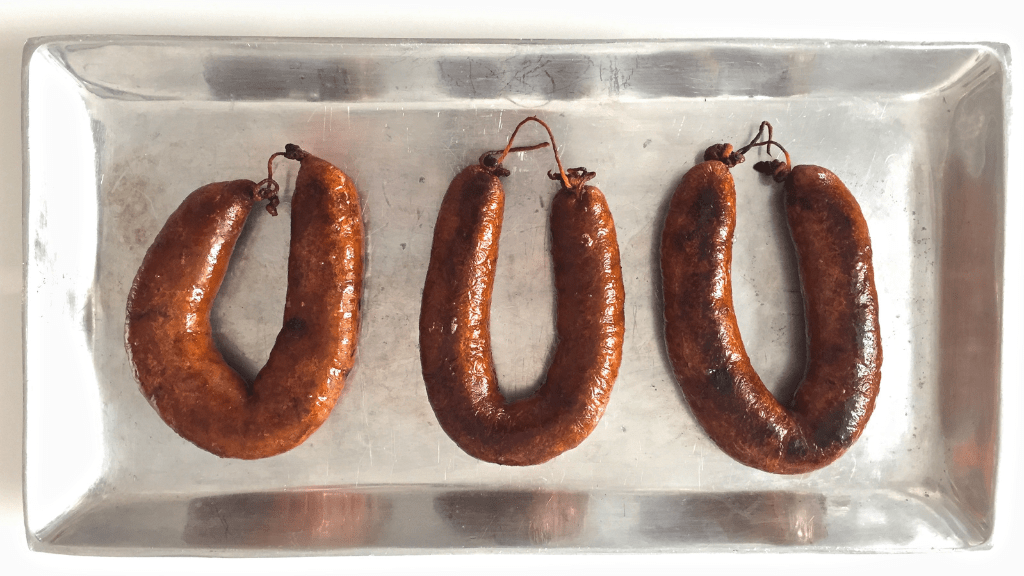
Portugal has a varied and appetizing range of cured meats and smoked sausages, which we refer to in Portuguese as enchidos. In between blood sausage, chouriço and other pork based creations such as bone and cartilage sausage (butelo), we find alheira, which is arguably the one Portuguese sausage with the most troubled background.
Most cured cuts of pork and sausages made with animals from other meats, whether in Portugal or elsewhere in the world, derived from the low waste mentality which scarcity has dictated throughout history. Before refrigeration was invented, slaughtering a big animal such as a pig, would translate into having larger amounts of food than those you’d be ready to consume before the fresh meat would spoil. This is why you’d start by preparing dishes with the fresh blood which would last the shortest, and afterwards stuff meat, fat and seasonings in pork casings, which would be cured to last virtually until the next slaughter would take place. Traditionally, we’d be talking about something that would happen once a year, before the beginning of winter.
How pressure from the Inquisition and Jewish ingenuity gave raise to the alheira
Even though the freedom to choose your own faith is a taken for granted reality in Portugal today, it hasn’t always been this way. About 500 years ago, during the times of the Inquisition, the government allied with the church started enforcing the Christian religion upon the masses, in a country where there were some religious minorities, namely Jews. Curiously, the Inquisition started in Spain in 1492, during the reign of Ferdinand of Aragon and Isabella of Castile. This is when the Moors (who also had a tremendous impact on the food habits of the Iberian Peninsula) were at last expelled from the Spanish territory, ensuing a time of religious fervor. Once the Muslims were to no longer coexist with other religions in the region, it was time for the Catholic powers to express and impose themselves more than ever. This is when the Inquisition started forcing Jews to convert to Christianity, something that drove a considerable number of Jewish families to escape across the border to Portugal, where they could stay true to their faith and live peacefully. But unfortunately that didn’t last very long either.

Soon enough, Portugal followed Spain’s steps and Jewish people now calling Portugal home were given an ultimatum: they could either convert to Christianity or leave. Statistics at the time would tell you that most Jews converted but what happened in reality is that a tremendous dose of ingenuity went into making the world believe that it had indeed been so, while behind closed doors remaining Jewish both in terms of beliefs and actual practices.
Alheiras came about during that time, as “former” Jews (now called new-Christians) were eager to show that they had finally embraced the food habits which other Christians also followed. For instance that included eating pork, something that the kosher laws of Judaism would forbid. They invented a sausage that would look like any other sausage, typically made with swine meat, but that would actually not contain any terefah ingredient, that is, foods seen as not fit in Judaism. As sausages were traditionally prepared at home and left to hang by the fireplace (fumeiro) to cure between several days to several weeks, Jews started preparing alheiras that would make anyone coming by the house, from simple neighbors to actual interrogators, believe that they had effectively converted to Christianity as they (theoretically) would eat pork now.
In reality, alheiras, whose name roughly translates as “garlicky” or “made with garlic”, contained small game meats (such as hare) and home-raised poultry, shaped to resemble traditional sausages with the aid of mashed bread, lots of garlic and other seasonings.
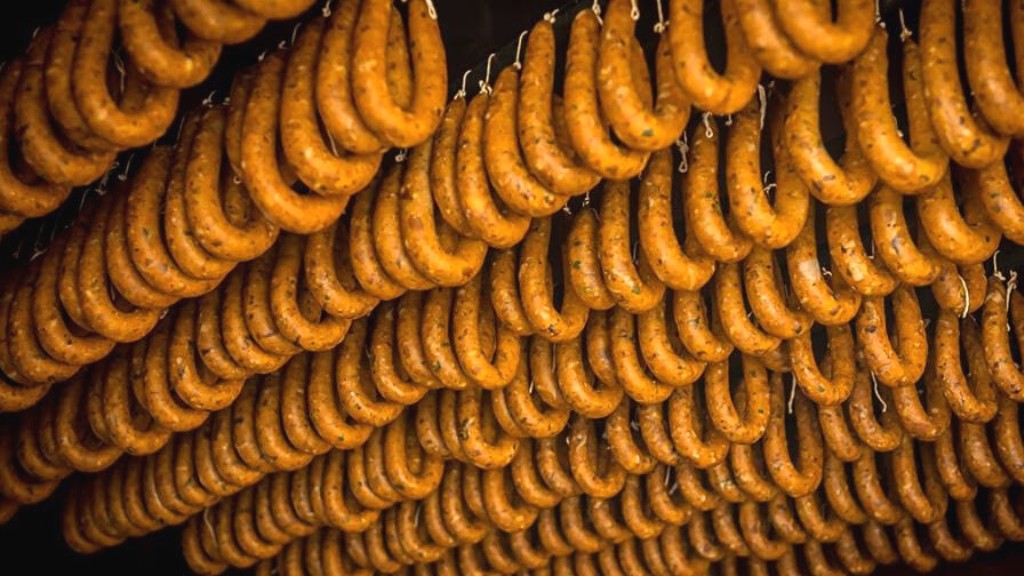
When you purchase an alheira now-a-days, it can be prepared similarly to the original ones or actually contain pork meat – something that would have been so shocking for Jews whose lives were spared thanks to delicious inventions such as alheiras about five centuries ago! To eat pork-free alheira, you ought to look for alheira de caça, which translates as game meat alheira, and which can contain several meats such as those from duck, chicken, rabbit and wild boar. Default alheiras (particularly if there’s no further explanation) will most likely contain pork meat or, at the very least, pork fat.
As religious persecution during the Inquisition times started mostly around the capital, those wanting to preserve their religious identity first moved towards the interior of Portugal, namely to the regions of Beira Interior and all the way up north to Trás-os-Montes, an area of the country which was historically removed from the rest of the national territory because of the difficult access to its rugged mountainous terrain. Thanks to the concentration of Jews in this part of Portugal, Trás-os-Montes cuisine has become linked with the use of alheiras. So much so that we often refer to this sausage as alheira de Mirandela, from the town of the same name, which today has PGI Protected Geographical Indication status, and has been voted by the masses as one of the Seven Wonders of Portuguese Cuisine. Even though many would argue that they aren’t actually from this one specific place, this overall region of Portugal is indeed famous for its high quality cured sausages prepared following artisanal methods, something you can taste if you attend the yearly smoked meats fair of Vinhais (Feira do Fumeiro de Vinhais), which is one of the best food festivals in Portugal.
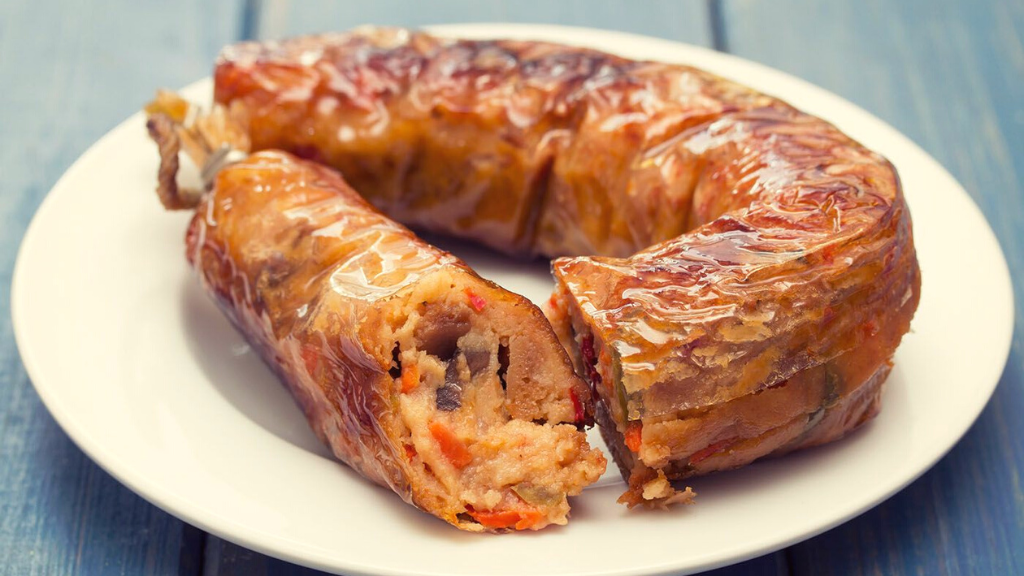
From its inception about 500 years ago until today, allheira has changed from kosher to sometimes containing pork meat and, or even salted cod in its seafood version. And, in more recent years, you can even find plant-based alheiras in the market – as pictured here. As this is the type of sausage we like to eat on its own but that we also use a lot to enhance the flavor of other dishes (such as stews with legumes, scrambles, pies and more) it is one of those genuine nostalgic Portuguese flavors no one would like to miss out on, not even vegans.

The most typical Portuguese recipes with alheira
When you eat alheira, one of the first things to keep in mind is that it won’t have the typical texture you might expect from a regular meat based sausage. Alheiras are mushy, very much like Jewish kishka, a type of kosher sausage prepared with meat and flour which is traditionally eaten during Sabbath, and that is also reminiscent of Portuguese farinheira, another type of sausage which came about similarly to alheira, in this case with actual flour as a binder versus soaked bread.
Grilled alheira
 The most straight-forward way to eat alheira would be grilled or pan-fried. Purists would argue that you do not fry alheira, that it is greasy enough on its own. While that is true, it’s also a fact that the skin of the alheira will tend to burst when in contact with the heat, thus releasing fat during the cooking process – enough of it and you’ll have the alheira frying in its own juices. If you do not care about counting calories and would like to try alheira in its more indulgent form, ask for alheira com ovo e batatas, that is a whole cooked alheira, served with a fried egg on top (just like we very often do when we eat beef steak), french fries and, maybe (just maybe), a little side salad. Alheira de caça (the one which does not contain pork) will very often be served with sauteed turnip greens and, to act as a balancing ingredient with the heavy alheira, boiled potatoes instead of fries.
The most straight-forward way to eat alheira would be grilled or pan-fried. Purists would argue that you do not fry alheira, that it is greasy enough on its own. While that is true, it’s also a fact that the skin of the alheira will tend to burst when in contact with the heat, thus releasing fat during the cooking process – enough of it and you’ll have the alheira frying in its own juices. If you do not care about counting calories and would like to try alheira in its more indulgent form, ask for alheira com ovo e batatas, that is a whole cooked alheira, served with a fried egg on top (just like we very often do when we eat beef steak), french fries and, maybe (just maybe), a little side salad. Alheira de caça (the one which does not contain pork) will very often be served with sauteed turnip greens and, to act as a balancing ingredient with the heavy alheira, boiled potatoes instead of fries.
Scrambled eggs with alheira
 In Portugal scrambled eggs are regarded as an appetizer or petisco, not at all as a breakfast food. Particularly if you enrich your eggs with alheira (ovos mexidos com alheira)! Alheiras have such a strong meaty taste that they are actually great to add depth of flavor to otherwise simple preparations, like eggs. Scrambled eggs with farinheira (ovos com farinheira) are also fairly common in taverns across Portugal, and are customarily eaten alongside other snacks or, if nothing else, with some bread.
In Portugal scrambled eggs are regarded as an appetizer or petisco, not at all as a breakfast food. Particularly if you enrich your eggs with alheira (ovos mexidos com alheira)! Alheiras have such a strong meaty taste that they are actually great to add depth of flavor to otherwise simple preparations, like eggs. Scrambled eggs with farinheira (ovos com farinheira) are also fairly common in taverns across Portugal, and are customarily eaten alongside other snacks or, if nothing else, with some bread.
Alheira croquetes
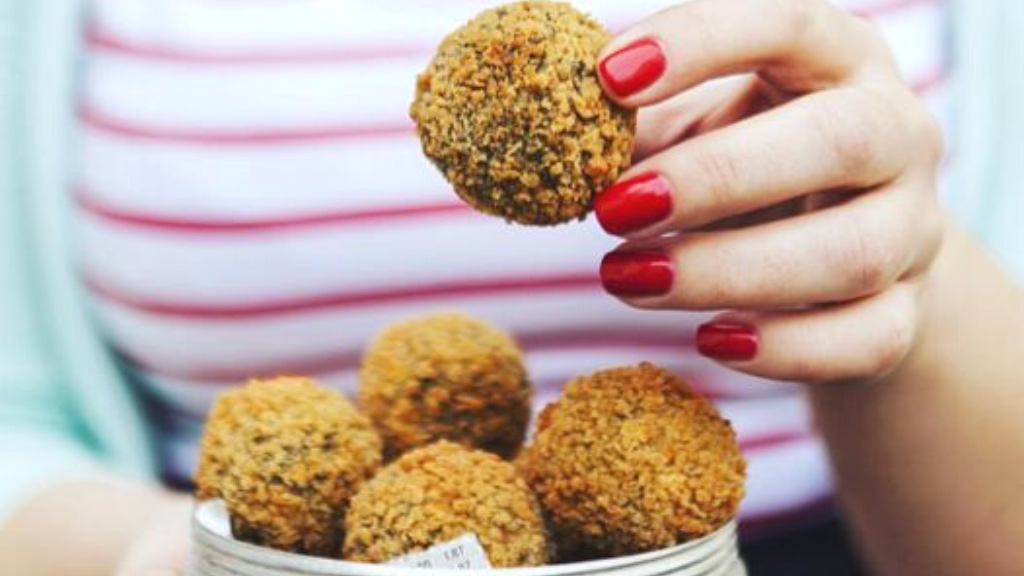 Who doesn’t love a good fried snack? The range of typical Portuguese savory snacks includes croquetes de alheira, sometimes also known as bolinhas de alheira, that is meat fritters made with mashed alheira and other binding ingredients, breaded and deep-fried. These are flavor bombs which are bound to get your juices flowing before a main meal!
Who doesn’t love a good fried snack? The range of typical Portuguese savory snacks includes croquetes de alheira, sometimes also known as bolinhas de alheira, that is meat fritters made with mashed alheira and other binding ingredients, breaded and deep-fried. These are flavor bombs which are bound to get your juices flowing before a main meal!
Where to eat alheira in Lisbon
Grilled alheira (made with pork or a mix of poultry and game meats, that is, alheira de caça) is the type of food you will very commonly come across in a typical Portuguese tasca. More and more you will also find snacks such as meat fritters flavored with alheira, or even scrambles, but for those you will probably have to visit more specific establishments.
Here are some suggestions:
Salsa & Coentros
Eat a straightforward alheira with fries
📍Rua Cel. Marques Leitão 12, 1700-337 Lisbon
https://restaurantesalsaecoentros.pt
Tasquinha do Lagarto
Try the grilled alheira de caça
📍Rua de Campolide 258, Lisbon
www.facebook.com/tasquinhadolagarto
Da Prata 52
Snack on alheira croquetes
📍Rua da Prata 52, 1100-150 Lisbon
Tapisco
Go for the scrambled eggs with alheira (pictured here)
📍Rua Dom Pedro V 81, 1250-096 Lisbon
Lovecraft Gastropub
The alheira fritters with pear purée are a great appetizer
📍Rua da Boavista 28, 1200-067 Lisbon
www.instagram.com/lovecraftportugal
Kong – Food Made With Compassion
In this vegan restaurant, they also have plant-based alheira croquetes
📍Rua do Crucifixo 30, 1100-183 Lisbon
www.instagram.com/kongveganfood
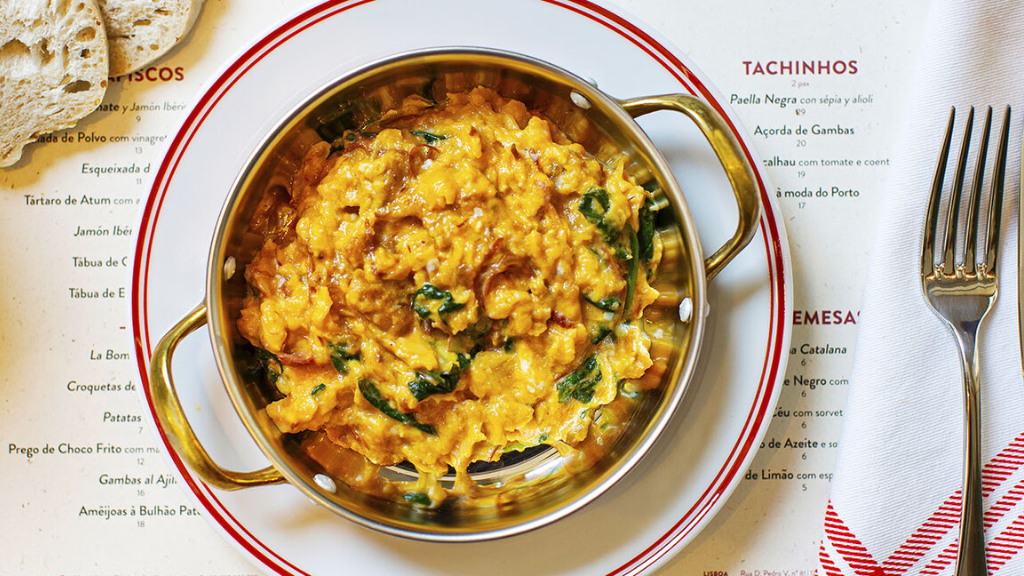
Don’t you just love how new foods keep emerging thanks to different historical and social contexts? This is the kind of information we share during our food and cultural experiences in Lisbon, as well as via frequent posts on Instagram. Follow #tasteoflisboa and tag us in your posts: @tasteoflisboa
Feed your curiosity on Portuguese food culture:
Enchidos: must-try Portuguese sausages and cured meats
Best egg based dishes you must try in Lisbon
The most iconic traditional grocery stores in Lisbon
Must-try Portuguese savory snacks (that aren’t cod fritters)
Real people, real food. Come with us to where the locals go.
Signup for our natively curated food & cultural experiences.
Follow us for more at Instagram, Twitter e Youtube
